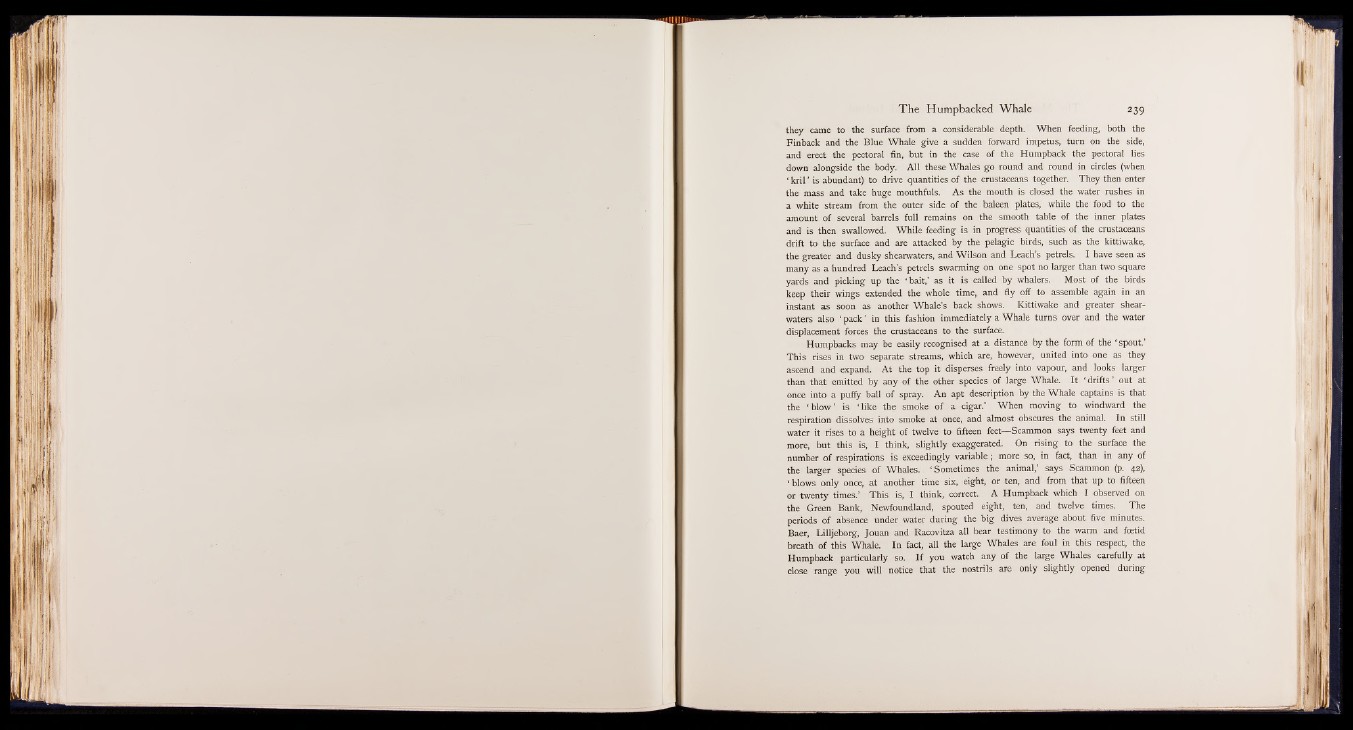
they came to the surface from a considerable depth. When feeding, both the
Finback and the Blue Whale give a sudden forward impetus, turn on the side,
and erect the pectoral fin, but in the case of the Humpback the pectoral lies
down alongside the body. All these Whales go round and round in circles (when
‘ kril ’ is abundant) to drive quantities of the crustaceans together. They then enter
the mass and take huge mouthfuls. As the mouth is closed the water rushes in
a white stream from the outer side of the baleen plates, while the food to the
amount of several barrels full remains on the smooth table of the inner plates
and is then swallowed. While feeding is in progress quantities of the crustaceans
drift to the surface and are attacked by the pelagic birds, such as the kittiwake,
the greater and dusky shearwaters, and Wilson and Leach’s petrels. I have seen as
many as a hundred Leach’s petrels swarming on one spot no larger than two square
yards and picking up the ‘ bait,’ as it is called by whalers. Most of the birds
keep their wings extended the whole time, and fly off to assemble again in an
instant as soon as another Whale’s back shows. Kittiwake and greater shearwaters
also ‘ pack’ in this fashion immediately a Whale turns over and the water
displacement forces the crustaceans to the surface.
Humpbacks may be easily recognised at a distance by the form of the ‘ spout.’
This rises in two separate streams, which are, however, united into one as they
ascend and expand. At the top it disperses freely into vapour, and looks larger
than that emitted by any of the other species of large Whale. It ‘ drifts’ out at
once into a puffy ball of spray. An apt description by the Whale captains is that
the ‘ blow’ is Tike the smoke of a cigar.’ When moving to windward the
respiration dissolves into smoke at once, and almost obscures the animal. In still
water it rises to a height of twelve to fifteen feet— Scamtoon says twenty feet and
more, but this is, I think, slightly exaggerated. On rising to the surface the
number of respirations is exceedingly variable; more so, in fact, than in any of
the larger species of Whales.. ‘ Sometimes the animal, says Scammon (p. 42)i
‘ blows only once, at another time six, eight, or ten, and from that up to fifteen
or twenty times.’ This is, I think, correct. A Humpback which I observed on
the Green Bank, Newfoundland, spouted eight, ten, and twelve times. The
periods of absence under water during the big dives average about five minutes.
Baer, Lilljeborg, Jouan and Racovitza all bear testimony to the warm and foetid
breath of this Whale. In fact, all the large Whales are foul in this respect, the
Humpback particularly so. I f you watch any of the large Whales carefully at
close range you will notice that the nostrils are only slightly opened during